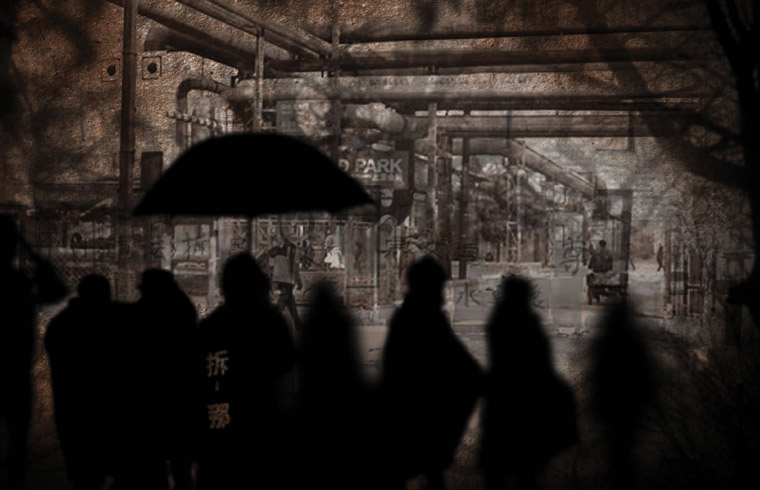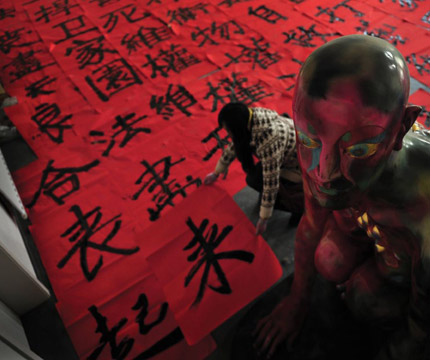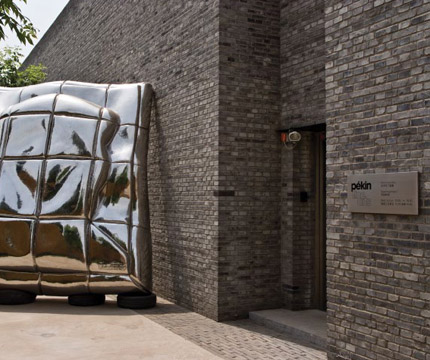A YEAR OF INTERVENTIONS
| February 11, 2011 | Post In LEAP 7

In late 2009 and early 2010, the hot topic in Beijing art circles was the relocation of the arts districts and the attendant legal complexities. With the rise of real estate speculation and a new round of construction planning for the city’s Chaoyang district in the first half of 2009, most of the town and village land within the district just outside the Fifth Ring Road faced the prospect of repurposing. According to current rules governing land use, the dozen or so art communities located in the northeastern suburban arts districts, originally developed on land rented from farmers, did not conform to land-use regulations. Of course the now iconic Factory 798 and the lesser-known but officially sanctioned Liquor Factory and Yi Hao Di districts were not under threat— these are shop windows for China’s new creative class. The problem was for the other 90% of Beijing art districts, where many of the city’s artists had made their homes and studios. Suddenly, more than a thousand studios were slated for demolition.
In the months following the release of the new plan, rumors proliferated. Landlords and developers reassured anxious artists that their buildings would not be torn down, and their rent and heating bills were collected as usual. But in November 2009, demolition notices appeared in the 008 Art Zone in Jinzhanxiang and the nearby Zhengyang Creative Art Zone. Soon after, developers, refusing to negotiate breach-of-contract compensation with artists, announced official deadlines for artists to vacate their studios. Water, electricity, and gas were shut off. Doors were sealed and a number of incidents of intimidation and violence were reported.

Artists began organizing events to protect their rights. Two of the four events in the series “Warm Winter” took place in 008 and Zhengyang, the areas under the most pressure. The largest event, “Versed in Culture, Skilled in Warfare,” was held on January 21, 2010. The organizers staged a discussion forum and a sports meet. The sports meet, held in Zhengyang, saw more than twenty artists compete in tug-of-war, using physical activity to demonstrate their determination to protect their rights. In the negotiation-themed discussion forum at the Jiangfu Art Center, participants debated methods for resolving the demolition predicament— relying on legal aid, going after unscrupulous developers, seeking protection within the legal system, and so on. As the artists determinedly sought reasonable and lawful protection of their rights, “Warm Winter” received increasing attention from the media and the public. Public pressure led to the resolution of compensation issues arising from the demolition of certain art communities.
“Warm Winter” ended, and large-scale demolition severely damaged the spontaneously formed art communities in Chaoyang. However, these events stoked an ongoing public discussion of China’s present land system, as well as demolition-related legal problems and urban development models driven by economic benefit. The “Warm Winter” events gave a voice to the anxieties and objections of not only the individual artists involved, but also the vast majority of society. In that sense, this was just the first in a series of large-scale activities and organized social interventions staged by contemporary artists in 2010.
In June, after a developer came under suspicion of illegally filling in East Lake in Wuhan, two local artists organized a program called “An East Lake for Everyone” (see LEAP 6). And then, at the end of the year, there was that banquet in Shanghai— its host shall not be named— that turned out to be not so harmonious after all. Although these events had different causes, locations, goals and formats, they demonstrated that artists no longer speak up only as individuals. In 2010 we instead saw the establishment of a foundation for community-based activism. Considering the circumstances of these various events, two concepts rise to the surface: land and law.

As development and modernization progress, the commodification of China’s land continues to intensify. As New Yorker correspondent Evan Osnos recently wrote, struggles over demolition have become “the national psychodrama, the defining battle over power and fairness.” Today, questions of land come to the fore in urban development plans, government revenues, and in the inclusion of real estate in GDP figures. Whenever we observe a public incident related to land, we see people turn to the law to resolve their problems. However, law can only resolve specific cases. The events in 2010, this year of interventions, show symptoms of a certain affliction in contemporary China. As Wang Chunchen, curator at the CAFA Museum, contends in his latest book Art Intervenes in Society: A New Artistic Relationship, the goal of these interventions is to “apply the freedom and unique thinking of artists to social phenomena, social environments, social problems, and social systems. . . Its way of thinking adopts positive attitudes and positive methods of intervention; it strives to expand the function of art to include new values and powers of expression. The work of artists is so diverse precisely because artists utilize independent critical and reflective energies.”
The expansion of large-scale activities through which art intervened in society in 2010 allowed us to observe a great deal of art-related debate. This debate possesses certain characteristics of openness. Each activity attempted to use various channels or media to fully open and propagate the public discussion. However, one question remains: from the perspective of the arts, were these activities really “art intervening in society,” or “society intervening in art?” Regardless, these activities certainly made us all quietly aware of the particular relevance and timeliness of contemporary art in the China of 2010.

